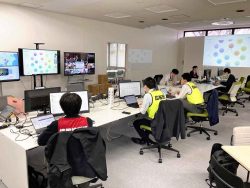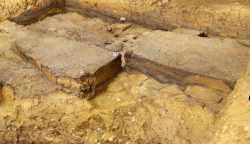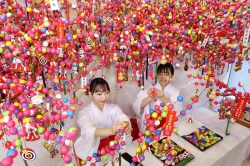Private War Archive Museums Disappearing in Japan Due to Owners’ Aging, Financial Difficulties; Hiroshima, Nagasaki Museums See Record Visitor Numbers
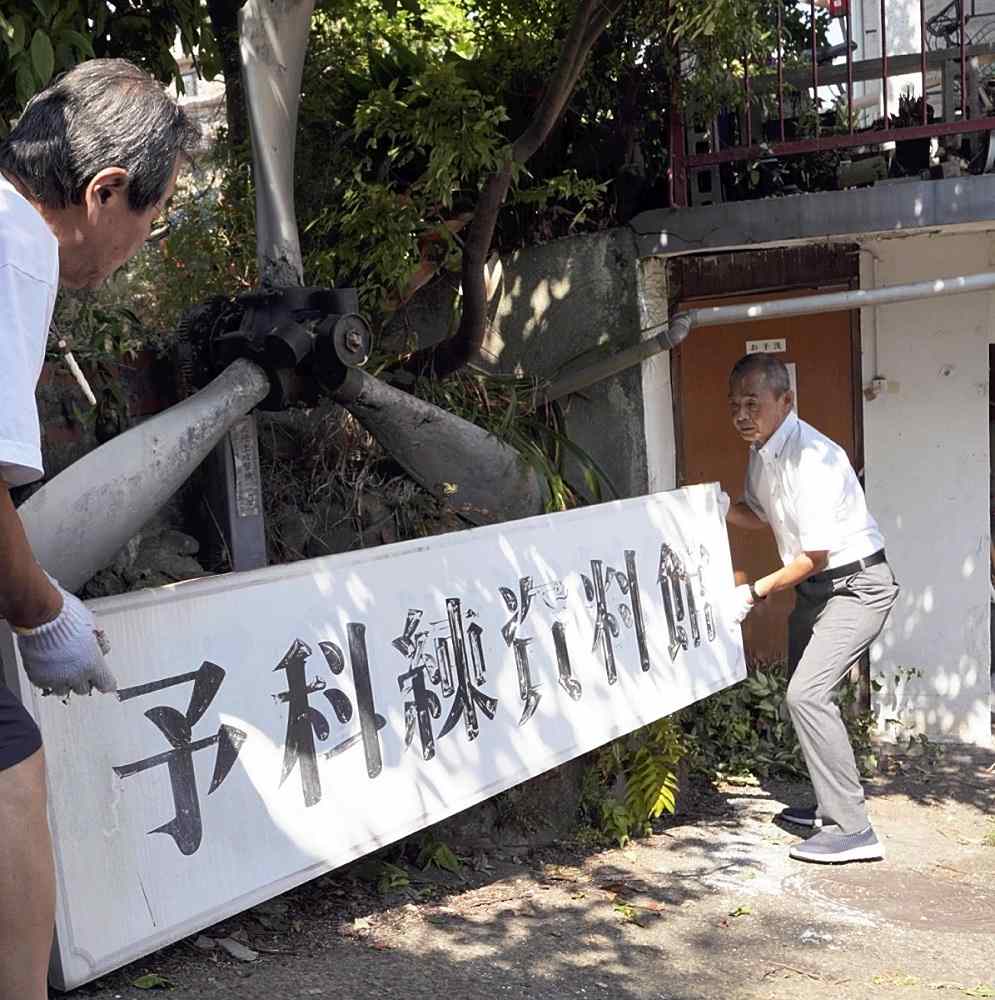
Takayasu Kawano, right, removes the sign of his war archive museum on Aug. 14 in Oita.
6:00 JST, October 6, 2024
Private war archive museums, established by individual war survivors to pass their memories of the Pacific War down to future generations, are disappearing across the country.
These museums tell visitors about the tragedy of the war through vivid testimonies and personal effects of the war dead. However, in many cases, the founders who personally experienced the war have passed away, and even the family members who took over the museums are getting older. Ahead of the 80th anniversary of the end of the war, efforts to preserve the tragedy are reaching a critical crossroads.
On Aug. 14, a private museum in Oita closed down. The museum had been opened by former kamikaze pilot Kiichi Kawano in his home and taken over by his son Takayasu, 68.
Kiichi survived due to the war ending the day before he was to go on a suicide mission. Takayasu said his father used to say, “I failed to die,” seemingly feeling guilty about having survived.
Kiichi renovated his home and opened the museum on Aug. 14, 1988. It displayed more than 3,000 artifacts, including photos of the deceased and farewell notes, donated by their war friends and bereaved family members.
Not only did he not charge admission, Kiichi also did not accept any subsidies from the municipal government or other organizations. Apparently, he felt that the museum was a place to console the souls of the war dead. He would offer incense sticks to photos of his wartime comrades every morning and evening and when visitors came, he showed them around the museum.
Kiichi died in 2021 at the age of 95. Takayasu took over the museum, however, as he is getting close to 70, he has found it difficult to manage the collection.
“As I don’t have a successor, I am the last who knows my father’s feelings towards the museum. I thought I should settle this while I am fit and well,” Takayasu said.
The museum’s collection will be donated to Gokoku Shrine in Oita.
Mission of survivors
Atago History Archive Museum in Maebashi closed down in 2020.
After a suggestion from air raid survivors, the local residents’ association established the museum in 2012, setting it up in a rented corner of a city-owned facility. The museum was popular because it allowed visitors to experience how people lived during the war.
However, the residents who showed visitors around the museum are aging and operators gave up on keeping it going.
“We continued to operate the museum because we believed that talking about the war was the mission of survivors. I miss it,” said an 86-year-old member.
An archive museum of air raids also closed down in Okayama in 2017. A man who had survived air raids had run the museum out of his home since 2000. The museum had thousands of materials, including documents collected from the U.S. National Archives and Records Administration and records of testimony from those who experienced air raids. All materials were donated to the Okayama Prefectural Archives.
According to Ikuro Anzai, professor emeritus of peace studies at Ritsumeikan University, who is well-versed in issues related to preserving war materials, war exhibitions were held by private bodies across the country. Some of the reasons for this were the intensifying Cold War in the 1980s and there being an increasing number of municipalities declaring themselves to be nuclear-free peace cities. Subsequently, war archive museums were established in various parts of the country.
“In Japan, people strongly think it is necessary to pass down their memories of the war to future generations. However, such museums, especially private ones, are difficult to maintain due to the aging of their operators and financial difficulties,” he said.
Hiroshima, Nagasaki see increase
While some archive museums are struggling to survive, others have seen an increase in visitors.
The Nagasaki Atomic Bomb Museum received more than 750,000 visitors last fiscal year, the most in 22 years, while over 1.98 million people — a record number — visited the Hiroshima Peace Memorial Museum in Naka Ward, Hiroshima.
“A time is coming when we will not be able to hear testimonies directly from hibakusha atomic bomb survivors. The significance of the museum will increase further,” an official at the Nagasaki municipal government’s peace promotion division said.
Last fiscal year, the Osaka International Peace Center saw a 20% year-on-year increase in its number of visitors. The center attributes the growth to the success of the special exhibition featuring kamikaze pilots held from January to March with the cooperation of the Chiran Peace Museum in Kagoshima Prefecture.
“It is difficult to increase the number of visitors through regular exhibitions alone. We would like to cooperate with facilities in other parts of the country and share war-related documents and artifacts with each other,” an official at the center said.
"Society" POPULAR ARTICLE
-

M4.9 Earthquake Hits Tokyo, Neighboring Prefectures
-

M7.5 Earthquake Hits Northern Japan; Tsunami Waves Observed in Hokkaido, Aomori and Iwate Prefectures
-

Tsukiji Market Urges Tourists to Avoid Visiting in Year-End
-

Israeli Tourists Refused Accommodation at Hotel in Japan’s Nagano Pref., Prompting Protest by Israeli Embassy and Probe by Prefecture
-
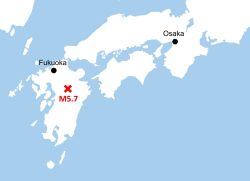
M5.7 Earthquake Hits Japan’s Kumamoto Pref., Measuring Upper 5 Intensity, No Tsunami Expected
JN ACCESS RANKING
-

Keidanren Chairman Yoshinobu Tsutsui Visits Kashiwazaki-Kariwa Nuclear Power Plant; Inspects New Emergency Safety System
-

Imports of Rare Earths from China Facing Delays, May Be Caused by Deterioration of Japan-China Relations
-

University of Tokyo Professor Discusses Japanese Economic Security in Interview Ahead of Forum
-

Japan Pulls out of Vietnam Nuclear Project, Complicating Hanoi’s Power Plans
-

Govt Aims to Expand NISA Program Lineup, Abolish Age Restriction





